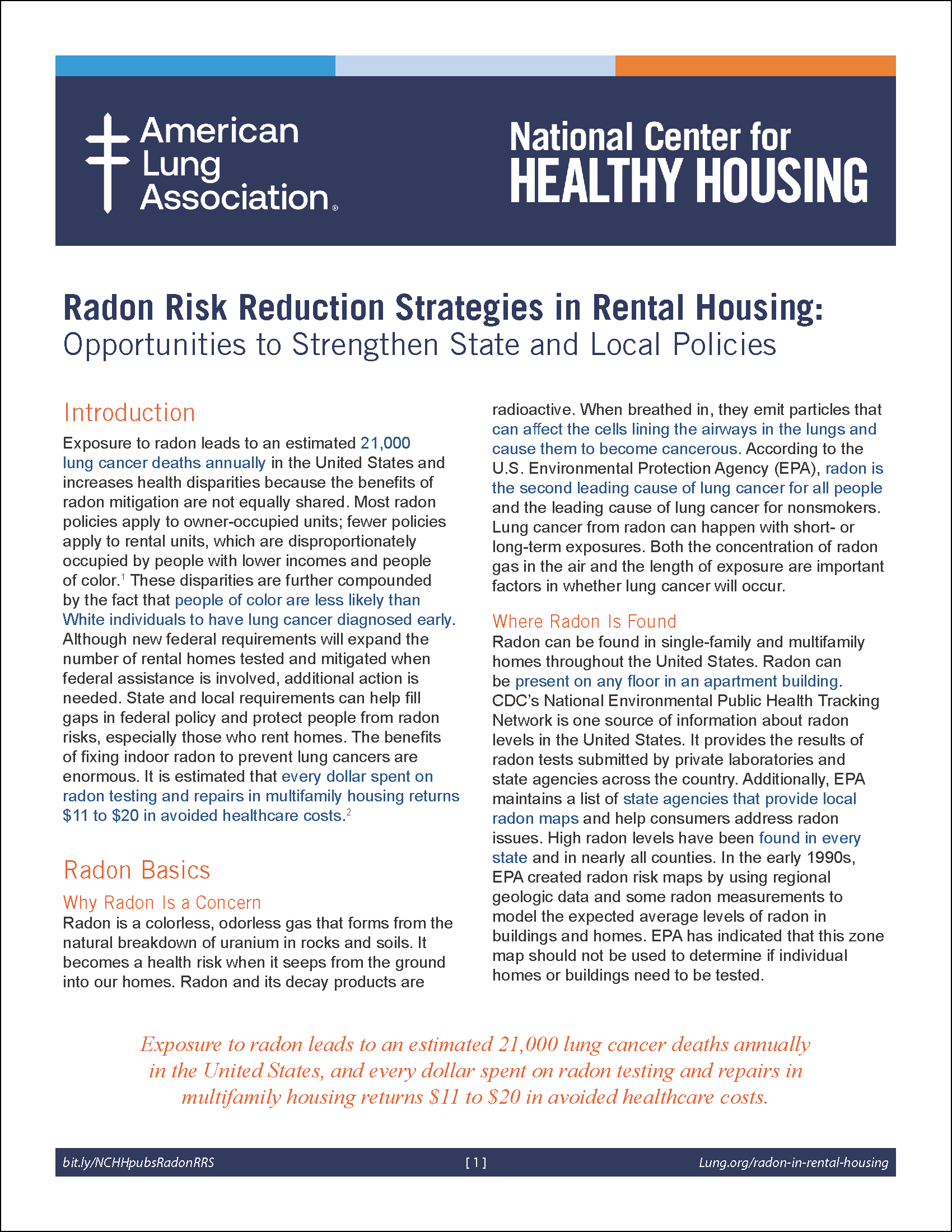New Policy Brief Highlights Critical Need for Stronger Radon Protections in Rental Housing
American Lung Association and the National Center for Healthy Housing Release Recommendations to Protect Renters from Lung Cancer-Causing Gas
Media Contacts: Jill Dale, jill.dale@lung.org; 312.940.7001 (O), 720-438-8289 (M) | Christopher Bloom, cbloom@nchh.org; 443.539.4154
CHICAGO, IL (July 11, 2023) — Today, the American Lung Association and the National Center for Healthy Housing released a policy brief to raise awareness about the issue of radon in rental properties and encourage local and state officials to implement recommended policies to reduce radon-caused lung cancer in the United States.
Radon is the second leading cause of lung cancer, and elevated radon levels are found in more than 1 in 15 homes in the U.S. Radon is a naturally occurring radioactive gas emitted from the ground that is odorless, tasteless, and colorless. The gas can enter a home through cracks in walls, basement floors, foundations, and other openings. Radon can be present at high levels inside homes, schools, and other buildings.
The policy brief, titled Radon Risk Reduction Strategies in Rental Housing: Opportunities to Strengthen State and Local Policies, highlights the need for additional state and local requirements to protect people who live in rental properties from radon. The report finds that while there has been an increase in federal action to address radon in rental properties in recent years, those policies only cover a fraction of the 48 million rental properties nationwide.
“Radon is found in homes in every state and nearly all counties in our country, in both single-family homes and apartment complexes. It can be present on any floor of a building. Because most policies to protect people from radon apply to homeowners, not renters, which are more likely to have lower incomes and be people of color, the recommended policies are critical in addressing health disparities in lung cancer,” said Harold Wimmer, National President and CEO of the American Lung Association.
Said Amanda Reddy, Executive Director of the National Center for Healthy Housing, “Radon exposure results in 21,000 deaths in the United States each year. Renters are highly vulnerable because they depend on their landlord to take actions to protect them from this odorless gas. State and local policymakers and advocates should read this report to learn what they can do to implement health-protective radon policies for rental housing.”
The policy brief includes recommended components for state and local policy action to protect tenants from radon-caused lung cancer, including:
- Require disclosure to tenants of known radon levels and a warning statement of potential radon risks.
- Require radon testing according to national standards in 100% of ground-contact units and not less than 10% of all upper-floor units.
- Require radon testing be performed by credentialed radon measurement professionals.
- Require mitigation in rental housing when radon levels are found to exceed EPA’s action level.
This policy brief supports the strategies outlined in The National Radon Action Plan, which was developed by the Environmental Protection Agency (EPA), along with strategic partners like the American Lung Association. The goal of The National Radon Action Plan is to eliminate preventable lung cancer from radon in the U.S. by expanding protections for all communities and buildings. In addition, the plan set a goal for the nation to find, fix, and prevent high indoor radon levels in eight million buildings by 2025; to prevent an average of at least 3,500 lung cancer deaths per year; and to save one quarter of a million lives in those buildings over time. The National Radon Action Plan was developed through a collaborative effort by the EPA, the American Lung Association, and 11 other organizations.
The American Lung Association has been involved with the development and implementation of The National Radon Action Plan since its inception in 2014 and works to reduce the health impacts on radon for all Americans.
The new policy brief, as well as more information about radon is available at bit.ly/NCHHpubsRadonRRS.
###
About the American Lung Association
The American Lung Association is the leading organization working to save lives by improving lung health and preventing lung disease through education, advocacy and research. The work of the American Lung Association is focused on four strategic imperatives: to defeat lung cancer; to champion clean air for all; to improve the quality of life for those with lung disease and their families; and to create a tobacco-free future. For more information about the American Lung Association, which has a four-star rating from Charity Navigator and is a Platinum-Level GuideStar Member, call 1.800.LUNGUSA (1.800.586.4872) or visit: Lung.org. To support the work of the American Lung Association, find a local event at Lung.org/events.
About the National Center for Healthy Housing
The National Center for Healthy Housing (NCHH) is a leading national nonprofit dedicated to transforming lives by transforming housing. Since 1992, NCHH has served as a highly regarded and credible change agent, successfully integrating healthy housing advocacy, research, and capacity building under one roof to reduce health disparities nationwide. Follow NCHH on Twitter (@NCHH), Instagram (@nchhorg), or LinkedIn, become a fan on Facebook, or subscribe to NCHH’s YouTube channel.
